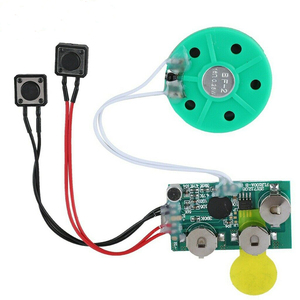
All categories
Featured selections
Trade Assurance
Buyer Central
Help Center
Get the app
Become a supplier

(26104 products available)














































sound module are essential components in the realm of passive electronic systems, playing a crucial role in sound-related applications. These components are designed to convert electrical signals into acoustic energy, facilitating the transmission and reception of sound waves. Typically found in audio systems, telecommunications equipment, and various consumer electronics, sound module are integral to ensuring optimal sound quality and performance. These components vary in design and functionality, catering to diverse acoustic requirements, thus making them indispensable in modern technology.
The spectrum of sound module encompasses a range of types, each suited to specific applications and environments. Common categories include microphones, speakers, buzzers, and piezoelectric devices. Microphones are designed to capture sound waves and convert them into electrical signals, with variations such as dynamic, condenser, and ribbon microphones catering to different audio needs. Speakers, on the other hand, convert electrical signals back into sound waves, with options ranging from full-range speakers to subwoofers for enhanced bass reproduction. Buzzers are utilized for alert and notification purposes, while piezoelectric devices are known for their precision in generating sound in compact spaces. The selection of sound module is crucial for achieving the desired audio output and functionality.
sound module offer a myriad of functions and features that enhance their performance in electronic systems. These components are engineered to provide high fidelity sound reproduction, ensuring clarity and precision in audio output. Features such as impedance matching, frequency response, and sensitivity levels are critical in determining the effectiveness of sound module. Impedance matching ensures optimal power transfer between components, while frequency response dictates the range of sound frequencies the component can accurately reproduce. Sensitivity levels, measured in decibels, indicate the efficiency of sound conversion, impacting the overall loudness and clarity. Advanced sound module may also incorporate noise-cancellation technologies, enhancing sound quality by reducing ambient noise interference.
The construction of sound module involves the use of specialized materials and techniques to achieve desired acoustic properties. Common materials include metals, ceramics, and polymers, each offering unique advantages in sound transmission and durability. Metals such as aluminum and copper are frequently used for their conductivity and resilience, while ceramics provide excellent piezoelectric properties for precise sound generation. Polymers are favored for their lightweight and flexible nature, allowing for innovative design possibilities. The choice of materials directly influences the acoustic performance, reliability, and longevity of sound module. Additionally, advancements in material science are paving the way for eco-friendly and sustainable options in component production.
Effective utilization of sound module requires an understanding of their application and integration within electronic systems. In audio systems, selecting the appropriate type and specification of sound module is vital for achieving the desired sound quality and performance. For telecommunications, these components are crucial for ensuring clear voice transmission and reception. In consumer electronics, sound module enhance user experience by providing high-quality sound output in devices such as headphones, smartphones, and home audio systems. Proper installation and calibration are essential to maximize the capabilities of sound module, ensuring they function optimally within their designated environment. Regular maintenance and testing can further ensure the longevity and reliability of these components, safeguarding the integrity of the audio system.
Selecting the appropriate sound module for your application involves considering several key factors. Understanding the specific requirements of your electronic system is paramount. For instance, the intended use—whether for telecommunications, consumer electronics, or audio systems—will dictate the type and specifications of the sound module needed. Considerations such as frequency range, sensitivity, and impedance must align with the overall design and functionality of the system. Additionally, environmental conditions, such as humidity and temperature, can influence the performance of sound module, necessitating careful selection to ensure reliability and longevity.
The selection of sound module should be based on the specific application and performance requirements. Key factors include the component's frequency response, sensitivity, and impedance. These characteristics determine how well the component will function within the desired system, impacting sound quality and efficiency. It's also important to consider the physical size and compatibility of the component with existing equipment, ensuring seamless integration.
Environmental factors such as humidity, temperature, and exposure to dust can significantly impact the performance of sound module. High humidity can affect the electrical properties and durability of the component, while extreme temperatures can alter its acoustic characteristics. Therefore, selecting components with robust materials and protective coatings can enhance their resilience in challenging environments.
Regular maintenance is crucial to ensure the optimal performance of sound module. This includes routine cleaning to remove dust and debris that could affect sound quality. Periodic testing and calibration can help identify any changes in performance, allowing for timely adjustments or replacements. Ensuring proper installation and handling can also prevent damage and extend the component's lifespan.
Ensuring compatibility involves matching the technical specifications and physical dimensions of different sound module. It's essential to verify that the impedance, frequency response, and sensitivity levels align with other components in the system. Additionally, compatibility checks should include the physical connectors and mounting options to ensure seamless integration.
Recent advancements in material science and technology are driving innovations in sound module design. The development of eco-friendly materials and miniaturization techniques are enhancing component performance while reducing their environmental impact. Innovations in noise-cancellation technologies and improved acoustic properties are also contributing to higher sound quality in various applications.